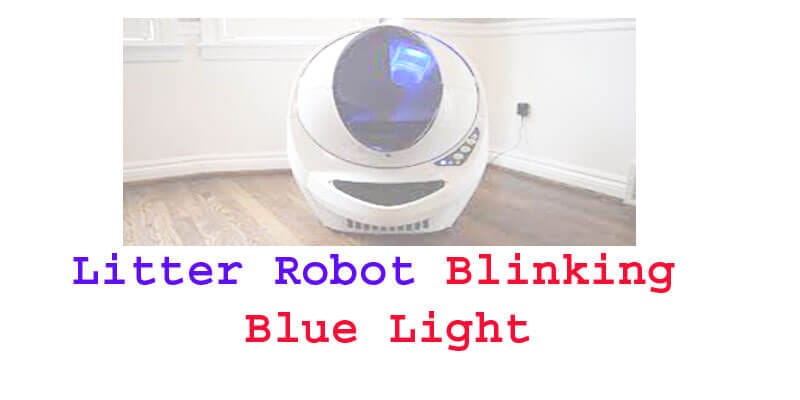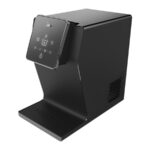The litter robot’s blinking blue light indicates a potential issue with the unit. In this article, we will explore the reasons why the blue light blinks and what actions you can take to resolve the problem.
Whether you’re a new owner or have been using the litter robot for a while, understanding the meaning behind the blinking blue light will help you maintain the functionality of your automatic litter box. So let’s dive in and find out what might be causing the blue light to blink.

Understanding The Litter Robot Blinking Blue Light Issue
The litter robot, as its name suggests, is a revolutionary self-cleaning litter box that takes the hassle out of maintaining a clean environment for your feline friend. However, you may encounter an issue where the litter robot’s blue light starts blinking, indicating that something isn’t quite right.
In this section, we’ll dive deeper into this problem and explore its significance.
What Is The Litter Robot?
The litter robot is an automated litter box that saves you from the daily chore of scooping out your cat’s waste. It has a built-in sensor that detects when your cat enters and exits, triggering a cleaning cycle that sifts and separates the waste from the clean litter.
The litter is then deposited into a waste drawer, eliminating any odor and providing a pleasant experience for both you and your furry friend.
Why Is The Blue Light Important?
The blue light on the litter robot serves as an indicator to let you know the status of the device. When everything is functioning properly, the blue light will remain steady, signifying that the litter robot is ready to use.
However, if the blue light starts blinking, it indicates that there is an issue that requires your attention.
Common Problems Associated With The Blinking Blue Light Issue
If you notice the blue light on your litter robot is blinking, it’s essential to troubleshoot the problem promptly. Here are some common problems that may cause the blinking blue light issue:
- Power interruption: A sudden power surge or outage can disrupt the litter robot’s normal functioning, leading to the blinking blue light.
- Sensor obstruction: The sensor that detects your cat’s entry and exit may be obstructed by litter, preventing it from functioning correctly.
- Waste drawer misalignment: If the waste drawer is not properly aligned or closed, it can trigger the blinking blue light as the litter robot detects an issue with waste disposal.
Importance Of Troubleshooting The Blinking Blue Light
Troubleshooting the blinking blue light is crucial to ensuring the smooth operation of your litter robot. By addressing the issue promptly, you can prevent any possible disruptions in your cat’s litter box routine. Here’s why troubleshooting is important:
- Keeps your cat comfortable: A malfunctioning litter robot can cause distress for your cat, potentially deterring them from using the litter box altogether. Troubleshooting ensures their comfort and encourages proper litter box habits.
- Maintains cleanliness: The litter robot’s self-cleaning system relies on proper functionality. Fixing the blinking blue light issue ensures that waste is discarded effectively, preventing any lingering odors or unsanitary conditions.
- Saves time and effort: By troubleshooting the blinking blue light issue, you can avoid future problems and save yourself from potential frustrations. Resolving the issue promptly will keep your litter robot running smoothly and alleviate the need for manual litter scooping.
Understanding the significance of the litter robot’s blinking blue light issue is crucial for maintaining your cat’s litter box experience. By troubleshooting and addressing the problem promptly, you can ensure a clean and hassle-free environment for both you and your furry companion.
Step 1: Checking The Connection
Before troubleshooting any issues with your litter robot’s blinking blue light, it’s important to first check the connection. Follow these steps to ensure everything is properly connected:
- Verifying power source: First, make sure that your litter robot is plugged into a working power source. Check if the power outlet is functioning by plugging in another device or using a different outlet.
- Ensuring the power cord is securely plugged in: Ensure that the power cord is securely plugged into the litter robot and the power outlet. If it feels loose, remove the cord and reinsert it firmly into both ends.
- Checking wi-fi connectivity: Confirm that your litter robot is connected to wi-fi. You can do this by following these steps:
- Open the litter robot app on your smartphone or tablet.
- Navigate to the settings section of the app.
- Select the wi-fi option and ensure that your litter robot is connected to your wi-fi network.
- If it’s not connected, try restarting your wi-fi router and reconnecting the litter robot to wi-fi.
By checking the power source, ensuring the power cord is securely plugged in, and checking wi-fi connectivity, you can troubleshoot the connection issue indicated by the blinking blue light on your litter robot. Remember to always refer to the official litter robot documentation for detailed instructions specific to your model.
Step 2: Examining The Waste Drawer
Upon observing a blinking blue light on your litter robot, it is essential to examine the waste drawer to ensure proper functioning. Follow these steps to clear any obstructions, check the carbon filter, and clean the waste drawer:
Clearing Any Obstructions:
- Carefully remove the waste drawer from the litter robot unit.
- Inspect the waste drawer for any obstructions that could be causing the blinking blue light.
- Clear away any accumulated litter or debris, making sure not to damage any components.
- Check the drawer guide rollers for any blockages or issues and resolve them as necessary.
- Once cleared, reinsert the waste drawer into the litter robot unit securely.
Checking The Carbon Filter:
- Locate the carbon filter compartment in the waste drawer.
- Remove the carbon filter and inspect it for dirt or excessive buildup.
- If the filter appears dirty or clogged, replace it with a new one.
- Ensure the carbon filter is inserted correctly in the compartment before continuing.
Cleaning The Waste Drawer:
- Remove the waste drawer from the litter robot unit.
- Dispose of the waste in an appropriate manner, taking care to follow proper disposal guidelines.
- Using a mild soap or pet-safe cleaner, thoroughly clean the waste drawer, inside and out.
- Rinse the drawer with clean water and allow it to dry completely before reinserting it.
- Regularly cleaning the waste drawer helps prevent odor and ensure optimal performance.
Following these steps to clear any obstructions, check the carbon filter, and clean the waste drawer will help resolve issues indicated by a blinking blue light on your litter robot. Enjoy a well-functioning and efficient litter disposal system for your furry friend!
Step 3: Reviewing The Sensor
Understanding the sensor’s role:
- The sensor plays a crucial role in the functioning of the litter robot, as it detects the presence of your cat and triggers the cleaning cycle.
- It is responsible for measuring the weight of your cat, ensuring that the device only activates when your furry friend is inside the litter box.
- By understanding how the sensor works, you can troubleshoot any issues and ensure optimal performance.
Cleaning the sensor:
- Over time, the sensor may accumulate dust or debris, which can affect its accuracy and performance.
- Regularly cleaning the sensor is essential to maintain its functionality. Here’s how you can do it:
- Begin by turning off and unplugging the litter robot to prevent any accidents.
- Gently clean the sensor with a soft cloth or a cotton swab. Be careful not to apply excessive pressure or use abrasive materials that may damage the sensor.
- Ensure that there is no remaining litter or debris in the sensor area.
- Once cleaned, plug in the litter robot and resume normal operation.
Adjusting the sensor sensitivity:
- The litter robot allows you to customize the sensor sensitivity to suit your cat’s weight and behavior.
- Follow these steps to adjust the sensor’s sensitivity:
- Locate the sensor range control dial on the back of the litter robot.
- Turn the dial clockwise to increase the sensitivity or counterclockwise to decrease it.
- Observe your cat’s behavior in the litter box to determine the ideal sensor sensitivity.
- Note that adjusting the sensitivity may require some trial and error to find the perfect setting for your cat.
Remember, understanding the role of the sensor, regular cleaning, and appropriate sensor sensitivity adjustment are key to ensuring that your litter robot operates smoothly and efficiently. By following these steps, you can provide your cat with a clean and hassle-free litter box experience.
Step 4: Evaluating The Globe
When it comes to the litter robot blinking blue light, it’s important to properly evaluate the globe to ensure its optimal functionality. Follow these steps to check the globe thoroughly:
Verifying the globe is properly aligned:
- Ensure that the globe is securely attached to the base.
- Make sure that the opening of the globe is properly aligned with the waste drawer.
- Double-check that there are no obstructions or foreign objects preventing the globe from turning smoothly.
Checking for any damage or debris:
- Inspect the globe for any cracks, leaks, or signs of damage.
- Remove any debris or clumps of litter that may have accumulated on the globe’s surface.
- Check for any clogs in the motor mechanism that could be causing the blinking blue light.
Lubricating the globe if necessary:
- Apply a thin layer of lubricant to the globe’s bearings to enhance its rotational movement.
- Use a silicone-based lubricant suitable for mechanical parts.
- Ensure that the lubricant is evenly distributed and not excessive to avoid attracting excess litter.
By following these steps, you can effectively evaluate the globe of your litter robot. This will help maintain its proper functionality and address any issues that may be causing the blinking blue light. Remember to perform regular maintenance checks to keep your litter robot running smoothly for your furry friend’s convenience and your peace of mind.
Step 5: Troubleshooting Other Possible Causes
Assessing The Led Light Strip
The LED light strip on your litter robot serves as an indicator to convey important information about the device’s status. If you notice a blinking blue light, it could suggest a potential issue that needs troubleshooting. Here are a few key points to assess the LED light strip:
- Observe the pattern: Take note of the frequency and duration of the blinking blue light. Each pattern signifies a specific message or error code.
- Consult the manual: Refer to the litter robot’s user manual or the manufacturer’s website to identify the meaning behind the blinking blue light pattern you are experiencing.
- Check the power source: Ensure that the litter robot is properly connected to a stable power source. A flickering blue light could indicate an intermittent power supply or potentially inadequate voltage.
Resetting The Litter Robot
If troubleshooting the LED light strip does not resolve the issue, resetting the litter robot might be necessary. Here are the steps to reset the device:
- Unplug the power cord: Disconnect the litter robot from the power source to initiate the reset process.
- Empty the waste drawer: Remove any litter or waste from the drawer to prepare for the reset.
- Wait for 10 minutes: Allow the litter robot to remain unplugged for at least 10 minutes. This break will enable the device to reset fully.
- Reconnect the power cord: Plug the litter robot back into the power source and wait for the blue light to stabilize.
Contacting Customer Support For Assistance
If both troubleshooting the LED light strip and resetting the litter robot fail to resolve the issue, it may be time to contact customer support for further assistance. Here’s how you can reach out to the manufacturer’s support team:
- Visit the manufacturer’s website: Look for the “contact us” or “support” section on their website.
- Call their customer support hotline: Obtain the customer support hotline number and dial it to speak directly with a representative who can guide you through additional troubleshooting steps.
- Send an email: If you prefer written communication, send an email to the manufacturer’s designated customer support email address. Provide them with a detailed description of the issue, including the blinking blue light pattern you observed.
Remember, reaching out to customer support ensures that you receive expert assistance in diagnosing and resolving the problem with your litter robot efficiently.
Tip 1: Regular Maintenance
Cleaning The Litter Box
Regular maintenance of the litter robot is essential to keep it clean and functioning optimally. Here are some key points to keep in mind for proper cleaning:
- Remove clumps of waste: In order to maintain a clean litter box, it’s important to regularly remove clumps of waste that accumulate over time. This will prevent any unpleasant odors and ensure a hygienic environment for your cat.
- Wipe the unit: Use a damp cloth or paper towel to wipe down the exterior of the litter robot. This will help remove any dust, dirt, or residue that may have built up over time.
- Clean the globe: The globe, where the litter is contained, should be cleaned periodically. You can do this by removing it from the base and emptying the litter into a trash bag. Then, wash the globe with mild soap and warm water, making sure to rinse it thoroughly before reassembling.
- Replace the carbon filter: The litter robot is equipped with a carbon filter that helps absorb odors. It is recommended to replace this filter every three to six months to maintain its efficacy.
Changing The Litter Regularly
Aside from regular cleaning, changing the litter on a consistent basis is crucial for a fresh and odor-free litter box. Consider the following points:
- Discard old litter: Completely empty the litter box and dispose of the old litter. This helps remove any accumulated waste and prevents the buildup of unpleasant smells.
- Choose the right litter: Use a high-quality litter that is suitable for the litter robot. Avoid litters that clump excessively or produce excessive dust, as this can impact the unit’s performance.
- Refill with fresh litter: After cleaning the unit, refill it with fresh litter. Make sure to follow the manufacturer’s instructions regarding the appropriate litter level to ensure optimal operation.
- Monitor litter levels: Regularly check the litter box to ensure the litter level remains within the recommended range. Add more litter as needed to maintain a consistent depth.
Checking For Any Loose Parts Or Screws
To ensure the litter robot continues to work properly and safely, it’s important to periodically inspect the unit for any loose parts or screws. Follow these guidelines:
- Inspect the base: Examine the base of the litter robot for any loose parts or screws. Tighten them if necessary to prevent any potential issues during the operation.
- Check the globe and filter chamber: Carefully inspect the globe and filter chamber for any loose components. Ensure they are securely in place to maintain the unit’s functionality.
- Test the sensor and motor: Make sure the sensor and motor are working correctly by following the manufacturer’s instructions for testing. If any issues are detected, contact customer support for further assistance.
- Observe for unusual noises or movements: Pay attention to any unusual noises or movements during operation. If you notice anything out of the ordinary, it may indicate a loose part or malfunction that needs to be addressed.
Regular maintenance, including cleaning the litter box, changing the litter regularly, and checking for loose parts or screws, is vital for proper operation and a pleasant experience for both you and your feline friend. By following these tips, you can ensure that your litter robot functions optimally and provides a clean and comfortable environment for your cat.
Tip 2: Using The Right Litter
Finding the appropriate litter for your cat:
- Consider your cat’s preferences: Cats have different preferences when it comes to litter. Some may prefer fine-textured litter, while others may like the feel of a coarser texture. Pay attention to your cat’s likes and dislikes when selecting litter.
- Opt for unscented litter: While scented litter may seem appealing to us, cats have a sensitive sense of smell. Strong scents can be overpowering for them and may lead to aversion to the litter box. Choose unscented litter to ensure your cat feels comfortable using it.
- Look for low dust litter: Cats are prone to respiratory issues, and dust from litter can worsen their symptoms. Opt for low dust litter to minimize respiratory discomfort.
- Consider clumping ability: Clumping litter makes cleaning the litter box easier by allowing you to remove only the soiled litter. Look for litter with good clumping ability, to ensure efficient and convenient litter box maintenance.
Avoiding litter with strong scents or clumping issues:
- Stay away from heavily scented litter: Strongly scented litter may seem like a good option for odor control, but it may overwhelm your cat. Cats have a strong sense of smell, and an overpowering scent can deter them from using the litter box.
- Avoid litter with clumping issues: Some litters may clump excessively or not clump well, making it difficult to clean the litter box effectively. Choose a litter that forms firm clumps, making it easier to remove waste without wasting clean litter.
- Test different brands and types: Every cat is unique, and what works for one may not work for another. Experiment with different brands and types of litter to find the one that suits your cat’s preferences and provides excellent clumping ability without strong scents.
Ensuring the litter does not block the sensor or impede the globe’s movement:
- Avoid litter with large particles: Litter with large particles can block the sensor or hinder the movement of the globe in the litter robot. Opt for litter with fine particles to prevent any obstructions and ensure the smooth functioning of the self-cleaning process.
- Keep the litter level appropriate: Ensure that the litter level in the litter robot is appropriate, without being too shallow or too deep. A proper litter level allows the globe to move freely without any hindrances.
Choosing the right litter for your litter robot is crucial to ensure a pleasant experience for both you and your cat. Consider your cat’s preferences, avoid strongly scented or clumping litter, and ensure the litter does not block the sensor or impede the globe’s movement.
By following these tips, you can maximize the effectiveness and convenience of your litter robot.
Tip 3: Proper Placement Of The Litter Robot
Finding the right spot for your litter robot is crucial to ensure its optimal functionality. Here are some key points to consider:
- Locating an appropriate area for the litter robot:
- Choose a quiet area: Place the litter robot in a calm and serene part of your home. Avoid areas with high foot traffic or excessive noise. This will help your cat feel comfortable and encourage them to use the litter box.
- Keep it accessible: Ensure that the litter robot is easily accessible to your furry friend. Avoid placing it in areas that are difficult to reach, such as tight corners or cramped spaces. This will help your cat feel at ease when using the litter box.
- Avoiding extreme temperature or humidity conditions:
- Moderate temperature: Extreme heat or cold can affect the performance of the litter robot. Avoid placing it in areas where it’s exposed to direct sunlight or extreme temperature fluctuations. Opt for a spot with a moderate temperature to maintain the device’s efficiency.
- Steer clear of humidity: Excess humidity can lead to clumping issues and affect the overall functioning of the litter robot. Avoid placing it in humid areas like bathrooms or laundry rooms. Instead, choose a spot with moderate humidity levels to ensure proper functionality.
- Ensuring there is enough space for the litter robot to function properly:
- Adequate clearance: Make sure there is enough space for the litter robot to rotate and operate smoothly. Keep at least a few inches of clearance on all sides to allow seamless movement of the device.
- Consider electrical outlets: If the litter robot requires an electrical outlet, ensure that the chosen location is within reach. This will prevent any inconvenience and make it easier to power the device.
Remember, finding the perfect spot for your litter robot is essential to provide a comfortable experience for your cat and maintain the efficiency of the device. Follow these guidelines to ensure proper placement and enjoy hassle-free litter box management.
Frequently Asked Questions Of Litter Robot Blinking Blue Light
Why Is My Litter Robot Blinking Blue Light?
The blinking blue light on your litter robot indicates that the unit is in sleep mode or currently cycling.
How Do I Fix The Blinking Blue Light Issue On My Litter Robot?
To resolve the blinking blue light issue on your litter robot, simply unplug the unit, wait a few minutes, and then plug it back in. If the issue persists, contact customer support.
What Does It Mean When The Litter Robot Blinks Blue?
When your litter robot blinks blue, it signifies that it is in the process of self-cleaning or in sleep mode. It’s a normal function of the unit.
Is A Blinking Blue Light On Litter Robot Normal?
Yes, a blinking blue light on your litter robot is normal. It indicates that the unit is functioning properly and either in sleep mode or undergoing the cleaning process.
Can I Stop The Litter Robot From Blinking Blue Light?
No, you cannot stop the litter robot from blinking blue light as it is a built-in feature indicating the status of the unit. It does not require any action on your part.
More Troubleshooting Guide
DYSON HAIR DRYER STOPPED WORKING RED LIGHTS LASHING: TROUBLESHOOTING GUIDE
Conclusion
To sum it up, the litter robot blinking blue light is a game-changer in the world of cat litter solutions. With its innovative design and smart technology, it takes the hassle out of maintaining a clean litter box. The blinking blue light feature not only adds a touch of modernity, but it also serves as a helpful indicator for various functions.
Whether it’s alerting you to a need for emptying the waste drawer or informing you about connectivity status, this feature ensures convenience and peace of mind. Additionally, the litter robot’s self-cleaning mechanism and odor control capabilities make it a must-have for cat owners seeking a hygienic and hassle-free litter experience.
It is a true investment in both your cat’s well-being and your own sanity. Make the switch to the litter robot blinking blue light and say goodbye to the never-ending chore of scooping litter. Your cat will thank you, and you will finally have time to focus on what truly matters – enjoying the precious moments with your feline friend.




